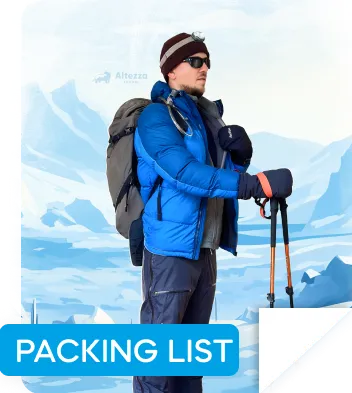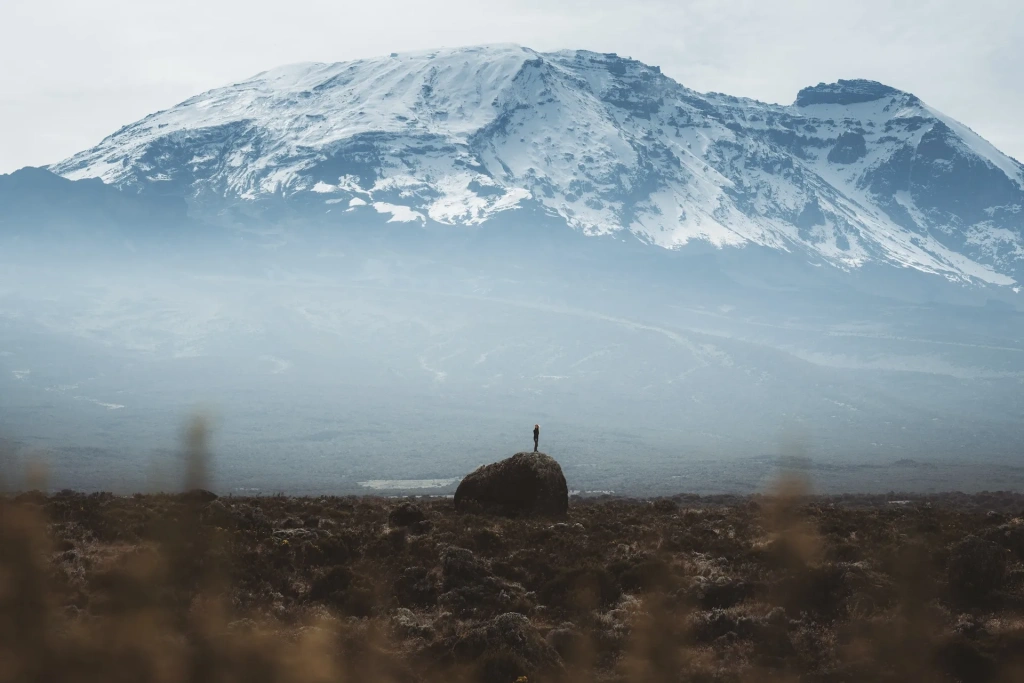Climbing Kilimanjaro requires protection from ultraviolet radiation as the high altitude and glacier cover near the summit increase exposure. Unlike in the Himalayas or the Andes, snow blindness and other complications are extremely rare here. In most cases, good-quality mountain sunglasses are enough.
Those who wear lenses or prescription glasses should consider specific factors related to comfort, hygiene, and the right type of eyewear. Learn more in this article by Altezza Travel.
Overview: vision-related challenges at high altitude
At high altitudes, ultraviolet exposure increases significantly: at around 4,000 meters (about 13,100 feet), its intensity is roughly 25–30% higher than at sea level. Additionally, snow and ice reflect up to 90% of UV rays, so your eyes receive double exposure.
According to observations, in the Himalayas, around 3% of mountaineers (including Sherpas) experience . This occurs when traveling across glaciers without proper eyewear. Other common issues include mild corneal swelling, small retinal hemorrhages, and temporary vision impairment — all of which disappear after descending.
Such issues are not seen on Kilimanjaro when using proper UV-protection sunglasses with reflective lenses. But what should those who wear contact lenses or prescription glasses do?
Glasses for climbing: what to choose if you have vision problems
At lower and mid altitudes (up to 2,500–3,000 meters / 8,200–9,800 feet), regular high-quality prescription glasses with built-in UV protection may suffice. But above 3,000–3,500 meters (9,800–11,500 feet), especially in snowy or icy zones, they are no longer enough.
Protection categories:
- Cat.0 — clear lenses (protection from wind/dust);
- Cat.1 — light tint (for cloudy weather);
- Cat.2 — medium tint (for city and everyday use);
- Cat.3 — dark lenses (bright sun, mountains without snow or glaciers);
- Cat.4 — very dark lenses (high mountains, Arctic zones, high altitude).
For Kilimanjaro, we recommend choosing glasses no lower than Cat.3, and ideally Cat.4 for bright areas near the summit. Look for the UV400 mark on the lenses — this provides maximum ultraviolet protection.
Some manufacturers note that modern photochromic glasses (also called chameleons) block 100% of UVA and UVB rays. However, their drawback is that in snowy conditions, they often fail to reach the highest tint level (max. Cat.3).
The best solution is mountaineering glasses with Category 4 protection and a 100% UV filter. There are three main options:
1. Over-glasses (OTG). Special mountain goggles or glasses designed to be worn over regular prescription glasses.
- Pros: the simplest and most affordable option.
- Cons: bulky, may press against the face, prone to fogging.
2. RX inserts (prescription inserts). A small internal frame fitted with prescription lenses, placed inside sports glasses or goggles.
- Pros: convenient, easy to change outer lenses (Cat.4, photochromic, yellow for fog).
- Cons: higher cost.
3. Custom prescription mountaineering glasses. Made by specialized optical workshops.
- Pros: most comfortable and efficient solution.
- Cons: expensive, longer wait time, filters cannot be swapped quickly.
Recommended brands:
Julbo specializes in mountain eyewear and produces models with RX inserts. Adidas Terrex, Oakley, and Smith Optics make sports glasses compatible with prescription inserts. Cébé and Bollé have alpine lines adapted for corrective lenses.
A common downside of all glasses is fogging in cold or high-exertion conditions. Experienced climbers bring anti-fog sprays or wipes (effective for 2–6 hours) or use ski goggles when it’s very cold.
Let’s summarize:
Contact lenses for climbing: pros, cons, and usage rules
Contact lenses don’t fog up, fit comfortably under a balaclava, and provide a wide field of vision. But high-altitude conditions bring their own challenges.
First, ultraviolet radiation. Some soft lenses are made with UV filters, but they only protect the cornea — not the entire eye. Therefore, they cannot replace proper mountaineering sunglasses. Some brands advertise sports lenses that are thinner, more breathable, and resistant to drying, but even these should always be worn together with Category 4 sunglasses.
Second, dry air. At high altitude, the tear film evaporates faster, so it’s important to bring preservative-free moisturizing drops (artificial tears in single-use vials). They help maintain comfort and reduce the risk of tiny corneal injuries.
Third, hygiene. Keeping lenses sterile during a mountain expedition is difficult. The risk of infection increases, especially if you store them in a container with solution. For this reason, doctors and experienced climbers recommend daily disposable lenses in the mountains — put them in in the morning and throw them away in the evening.
There are also continuous-wear lenses, but it’s better to avoid them at altitude: low oxygen levels, dryness, and limited hygiene make inflammation more likely.
In summary:
Safest solution: daily disposable lenses paired with high-quality mountain glasses (Cat.4 + UV400), plus a backup pair
FAQ about eyewear and contact lenses on Kilimanjaro
Which vision problems make climbing Kilimanjaro unsafe?
There are no strict restrictions. However, people with severe glaucoma or retinal diseases should consult an ophthalmologist before the climb.
Can contact lenses protect against UV radiation?
Partially. Many lenses come with a UV filter, but they only protect the cornea — the rest of the eye remains exposed. Therefore, lenses cannot replace glacier sunglasses with UV400 and Category 4 protection.
Are there glacier sunglasses with corrective lenses?
Yes. Some glacier sunglasses have prescription inserts (RX inserts), and others can be custom-made with corrective lenses. Brands such as Julbo, Adidas, and Oakley offer these models.
What are the main rules for wearing contact lenses during mountain trekking?
Use daily disposable lenses, never sleep in them, always bring moisturizing drops, and keep a spare pair of glasses.
Can photochromic (transition) glasses replace glacier sunglasses in the mountains?
Not recommended. They rarely darken enough to reach Category 4 protection, so in the arctic zone and under strong sunlight, they may not provide sufficient protection.
What to do if your glasses fog up?
Use anti-fog wipes or spray, and ventilate the glasses whenever possible.
Which eye drops are best for an expedition?
Moisturizing, preservative-free eye drops (“artificial tears”), preferably in single-use vials. They help relieve dryness and irritation.
What’s better for a long expedition, glasses or lenses?
The best option is to combine both: wear contact lenses during the day for comfort, and switch to glasses in the evening to let your eyes rest.
Checklist: eye protection gear for Kilimanjaro
Glasses
- Glacier sunglasses Cat.4 + UV400
- A second pair of sunglasses Cat.3 (for lower zones)
- Spare prescription glasses in a durable frame
Contact lenses (if needed)
- Daily silicone hydrogel lenses (enough for all expedition days + 2–3 extra pairs)
- Preservative-free moisturizing drops (single-use vials)
Care and protection
- Anti-fog wipes or spray
- Hard case + soft pouch for glasses
- Wet disinfecting wipes for hands

All content on Altezza Travel is created with expert insights and thorough research, in line with our Editorial Policy.
Want to know more about Tanzania adventures?
Get in touch with our team! We've explored all the top destinations across Tanzania. Our Kilimanjaro-based adventure consultants are ready to share tips and help you plan your unforgettable journey.

















